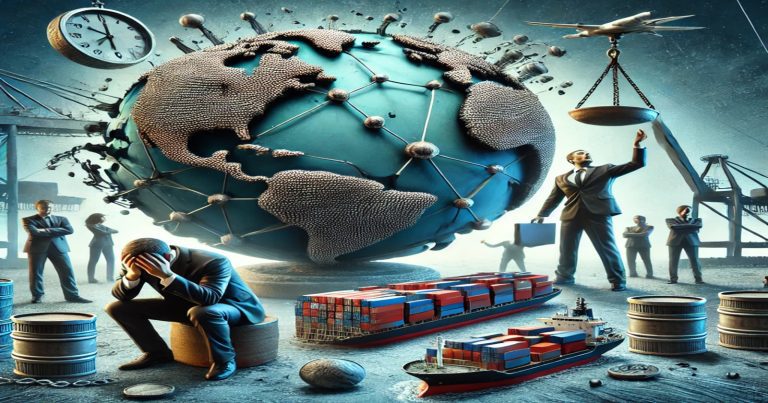International trade has been the growth factor for the economies of all nations. International trade allows exchanging goods and services between countries, entering new markets, and exploiting comparative advantages for economic gain. However, simultaneously, global trade has disadvantages, such as increasing efficiency, economic growth, and access to a broader variety of goods.
We will discuss the concept of international trade, its forms, and all the difficulties and dangers related to global trading, such as trade restrictions, currency fluctuations, political instability, economic dependency, and much more. The awareness of these disadvantages will benefit business owners and policymakers alike in devising a strategy for risk management in the face of growing international markets.
What is International Trade?
International trade refers to the buying and selling of goods, services, and capital crossing international borders or territories. It is a form of trade whereby a country derives products that it cannot produce efficiently. This stimulates specialization and economic growth.
For example, Saudi Arabia would export oil to other countries, Japan would export cars, and Brazil would export coffee. What they import and bring into that country are some goods and services that are less produced domestically and cheaper to get from other foreign countries.
Global trade has Two Major Features:
- Exports: Goods and services provided to foreign regions.
- Imports: Imported goods and services from other international countries.
While international trade promotes economic development and connects the world, it also exposes businesses and nations to numerous challenges, which we will discuss in detail.
Types of International Trade
Understanding the various forms of international trade is necessary to understand the complexity and risks involved. There are three major types:
1. Bilateral Trade
It involves the exchange of goods and services between two countries. Most countries with bilateral trade have developed a trade agreement with terms and conditions that guide their exchange, including terms on tariffs and quotas of imports, among others.
For example, The SA-Canada has been free to flow its goods due to the USMCA trade agreement.
2. Multilateral Trade
Multilateral trade involves the exchange of commodities among more than one country and is referred to as international trade. This entails WTO agreements and others. Such agreements reduce obstacles to trade at a global level.
Example: The European Union, EU supports free trade among its members. It reduces barriers to tariffs, making the customs procedure easier to follow.
3. Intra-Industry Trade
It is when various countries both export and import near-identical goods. For example, Germany can export cars to the USA but import vehicles to the USA. This has been noted to occur mostly in industries whose very existence is based mainly on product differentiation.
While this kind of trade opens one up to global opportunities, it is fraught with risks involving exchange rates, foreign markets, and politically unstable markets, which we cover in the section below.
Disadvantages of International Trade
While international trade boosts economic growth and global connectivity, it also presents significant challenges. The key disadvantages of international trade include economic dependency, job losses, and exposure to political and financial risks. Understanding these issues is crucial for businesses and policymakers.
Trade Barriers
Trade barriers are one of the most common disadvantages of international trade. These are restrictions governments impose to limit or control the movement of goods and services across borders. There are two kinds of trade barriers: tariff and non-tariff.
- Tariff Barriers: The tax imposed on imported goods to protect domestic industries.
- Non-Tariff Barriers: Import quotas, licensing requirements, and other obscure rules.
Although these barriers are created to protect the local industries, they raise the firm’s business cost and limit product diversity for the consumer. They also destroy global supply chains and make it challenging for firms to scale across borders.
Currency Fluctuations and Exchange Rate Risks
Currency fluctuations represent one of the worst cons that international trade suffers from. Fluctuation between the currencies of their respective economies occurs quite substantially. Factors affecting inflation, interest rates, and politics are responsible for this fluctuation. Therefore, an element of exchange rate risk arises on top of business operation profitability.
For instance, if a business firm has secured an export contract in dollars, then the same has risen significantly over this period. The local currency of this business firm can thus become very weak in comparison, and, hence, their revenues may become lost. To fight against such dangers, businesses are reluctant to hedge their position, increasing financial costs.
Political Instability and Foreign Market Risks
Political instability in another country’s markets may limit the export and importation business.
Events such as regime change, civil unrest, or foreign policy may create a political environment in another country’s market.
For example, embargoes imposed on certain countries may limit businesses from freely conducting international trade. A political decree can nationalize industries, and foreign investment and business assets abroad will become at risk.
Economic Dependence
Heavy international trading may lead a country to depend on its foreign markets. Importing goods and exporting back to specific nations makes a nation vulnerable to economic fluctuations that could be associated with those economies.
For example, oil reliance, as in Venezuela, leads to an economic crisis due to the drop in the world market prices of oils. The dependent position removes the capabilities towards self-managed control over economies during global recessions.
Current Account Deficits and Balance of Payment Problems
A trade deficit, where the level of imports increases above that of exports, generally creates problems with the balance of payment for the trading country by spending more foreign currencies than the sum earned from various export commodities of the country, which might even put it in debt.
It brings in problems like inflation and loss of investor confidence because of devaluation of the money of a nation suffering from deficits, and therefore, gradually starts showing reliance on borrowing from abroad in its national economic accounts.
Loss of Domestic Jobs
This is one of the most contentious disadvantages of international trade. The firms take manufacturing to countries with low labor costs and take the jobs away from the motherland.
For example, manufacturing jobs have had labor costs decrease in places such as China, Mexico and the USA. Companies save this expense, but it goes hand in hand with unemployment and wage stagnation in those industries.
Unfair Competition
It is cheaper to manufacture either of the products in one way, with subsidies from the government to foreign firms, and in the other, with a low competitive capability by the firms operating locally. Unfair labor and environmental conditions within that economy also make it a country of unfair business to those conducting businesses within such countries.
For instance, a business in the U.S. will never compete with a country with cheaper labor costs, even though the latter prides itself on quality in manufacturing its products. This pushes local businesses to close their shops and increases economic homogenization.
Import Restrictions and Export Limitations
Import restrictions, export bans, or regulations protect national interests, avoid food insecurity, or conserve strategic commodities. Such policies may placate local industries but can strangle business growth and disrupt supply chains.
Several countries ‘ export controls on medical equipment during the COVID-19 pandemic reserved critical needs in overseas markets.
Cultural Differences and Communication Disruptions
It generally involves more conflict and confusion between states in trade. Conversely, it brings complications from language restrictions toward other economic operations and sociological ways that make negotiations cumbersome.
For example, the best marketing campaign that has done exceptionally well in one country is inappropriate in another due to different cultures. A small mistake or miscommunication about the agreement will land both parties into litigations. Businesses will require cross-cultural training before executing such dealings.
Complexity in Legal and Regulatory Aspects
Every country has its laws for its trade, where taxation falls, labor laws, environmental regulations, and import restrictions. This increases compliance costs and risks with regulatory penalties for non-compliance.
For example, firms exporting to the European Union must meet very high environmental and safety standards. It is costly. Failure results in recalls, fines, or bans into the market.
Impact of Tariff Barriers on International Trade
Tariff barriers are levies placed on imported products by governments to protect local industries from competition by foreign producers. Even though tariffs raise revenue and support local companies, they remain one of the main negative implications of international trade.
Higher Prices
Tariffs add costs to the importation of goods, reducing the competitiveness of the imported goods compared to locally produced ones.
Retaliation
Countries on whom such tariffs are imposed retaliate with theirs and induce trade wars.
Low trade volume
Inflation creates additional costs to scare off more overseas trade, which means the ability to choose as many consumer products as possible, along with impacts within global supply lines.
The impact of such war in U.S.-China disputes is seen win how tariffs affect industrial trends, increase prices and destroy the exports and the importing sectors.
Disadvantages of International Trade FAQs
1. State one disadvantage of international trade.
Trade barriers, currency fluctuations, political instability, economic dependency, and loss of domestic jobs primarily mark International trade disadvantages.
2. How does currency fluctuation affect international trade?
Currency fluctuations give the risk of an exchange rate. It impacts profitability for cross-border transactions. The company sometimes loses its deal when the exchange rate turns unfavorable after striking a deal.
3. What is a trade deficit, and why is it a problem?
The country is said to have a trade deficit if imports are more than exports, which leads to problems in bathe lance of payments, devaluation of the currency, and long-term economic instability.
4. How does international trade lead to the loss of domestic jobs?
Companies tend to outsource their production to low-labor-cost countries, which tresulting in a loss of jobs in domestic manufacturing sectors, thus leading to unemployment and wage stagnation.
5. What are trade barriers?
Trade barriers include tariffs, quotas, and other regulatory measures that restrain imports and exports.


